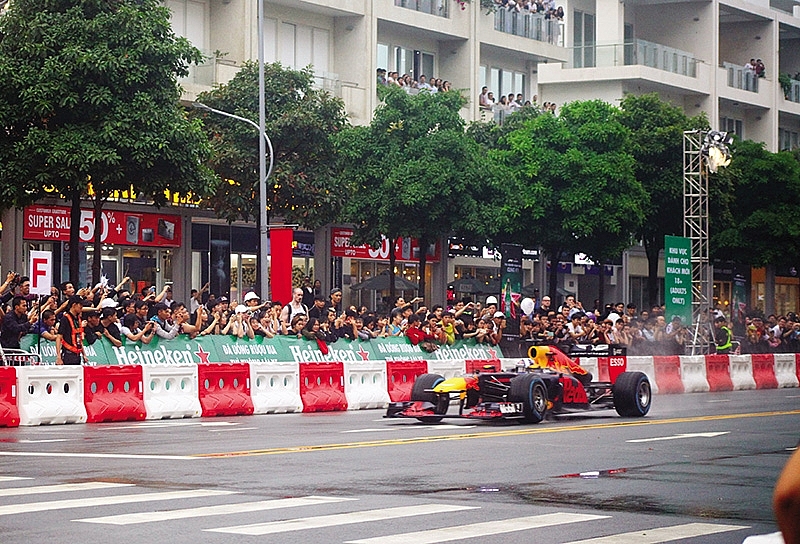Hanoi in pole position for F1 race tourist boost
 |
| Over several days of racing, an F1 Grand Prix in Hanoi could boost visitor numbers to four or five times the average level |
The International Automobile Federation’s (FIA) Formula One (F1) race director Charlie Whiting recently visited Hanoi to gauge the feasibility of bringing the race to the capital city. Autosport website quoted Whiting as saying a Hanoi Grand Prix will likely join the F1 calendar in 2020.
Whiting added that the track could be partially-built in the west of the city, about 12 kilometres from the centre of Hanoi, while existing road infrastructure will be made available to accommodate it.
“The technical premises and administrative building will be developed on current empty space, and so will part of the racing track, which would be used as regular roads after the completion of the race,” said the director.
Greig Craft, chairman of the Vietnam Automobile Club (AAV) and the sole representative of the FIA in Vietnam, had also revealed that the FIA is working with the Hanoi administration with the intention of creating an F1 race in Vietnam.
Recently, Chairman of the Hanoi People’s Committee Nguyen Duc Chung hinted at the negotiations with the F1 Organising Committee about the possibility of the capital city hosting the premier motorsport competition in the near future.
While no official information about the agreement has yet been released, a series of field surveys by FIA officials in Hanoi in recent months could signify that the announcement of a possible cooperative agreement is only a matter of time. Autosport website, among others, noted unnamed sources as saying a deal was “as good as done” and an official announcement could be made as early as next month.
F1 racing is often touted as the ‘World Cup’ of the global car racing circuit, and one of most worthwhile opportunities for image promotion for the countries and regions that host it annually.
Statistics show that each F1 race could draw more than 200,000 spectators who directly watch the competition, as well as hundreds of millions in audiences on television channels.
During the actual days of racing and qualifying, the number of visitors to the host city could jump four to five times the average level, on par with the peak tourism season.
In general F1 races take place in specially-built racing fields. In recent times, often to save on costs, many hosts such as Singapore and Monaco have shifted towards racing on common streets. The cost of hosting such events, however, remains vast. Logistics are also a problem – Miami was set for a new Grand Prix event in 2019 but constraint issues with creating the street circuit has led to delays. It has not been confirmed if the Hanoi track will be ready in time for the 2019 championship.
Still, the list of cities wishing to join the F1 club, a playground attracting a huge number of business participants, is ever-lengthening.
In reality F1 racing provides excellent opportunities for business promotions as brands can potentially appear on racer’s outfits, advertising billboards, trailers, and even on the cars themselves.
In August, Hanoi’s leaders proposed that the race take place around the My Dinh national sport complex, after an initial plan to organise the Grand Prix around Hoan Kiem Lake was ruled out.
Vuong Bich Thang, director of the General Department of Gymnastics and Sports, in a recent interview with VIR lauded leaders’ commitment to bringing the world’s most popular motor racing championship to Vietnam, and particularly to Hanoi.
“Hanoi’s hosting of the race will contribute to the development of fresh sports interest in Vietnam, as well as being a major step towards spreading Vietnam’s image to the global community,” he said.
Thang, however, emphasised the need for the capital to work on upgrading existing roads and auxiliary infrastructure in order to meet professional requirements, as well as ensuring safety for people in locations where the race takes place.
What the stars mean:
★ Poor ★ ★ Promising ★★★ Good ★★★★ Very good ★★★★★ Exceptional
Related Contents
Latest News
More News
- TCP Vietnam opens new youth sports yard in Danang (September 22, 2025 | 18:46)
- 'Run For The Heart' to return to Ho Chi Minh City this September (August 29, 2025 | 15:31)
- LION Championship 25 to feature title showdowns in Khanh Hoa (August 15, 2025 | 14:24)
- AFF Women’s Championship 2025: Vietnam defeat Thailand in tense showdown (August 15, 2025 | 14:21)
- Hung Yen win National U11 Football Championship – Nestlé MILO Cup 2025 (August 06, 2025 | 11:34)
- Vietnam win third consecutive ASEAN U-23 title (July 30, 2025 | 07:00)
- Game-changing tech and startups to star at Vietnam Sport Show (July 18, 2025 | 14:56)
- Vietnam women's team secure 6-0 victory over UAE in Asian Cup qualifiers (July 04, 2025 | 15:32)
- Herbalife Vietnam supports VnExpress Marathon Quy Nhon 2025 (June 17, 2025 | 17:38)
- Vietnam lose first Asian Cup qualifiers match against Malaysia (June 12, 2025 | 16:25)

 Tag:
Tag:





















 Mobile Version
Mobile Version